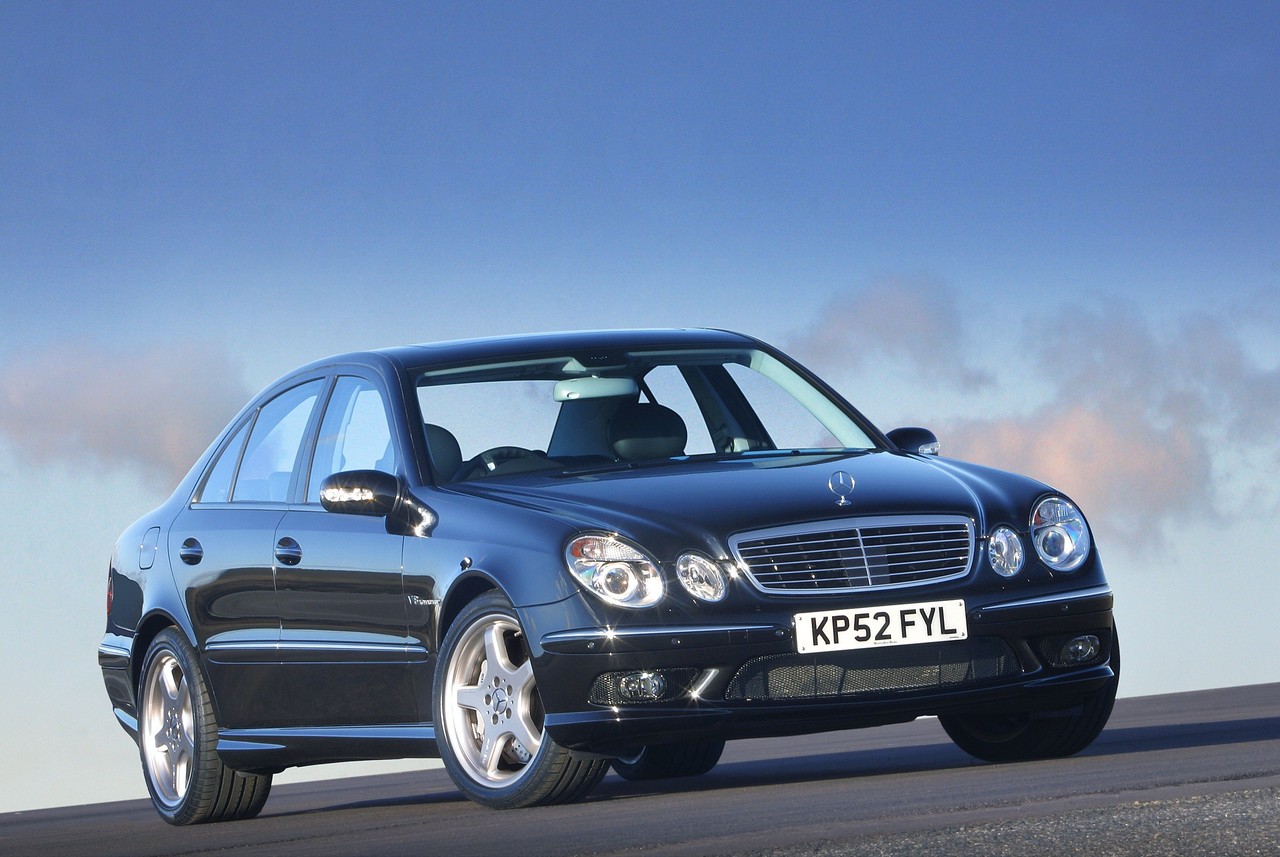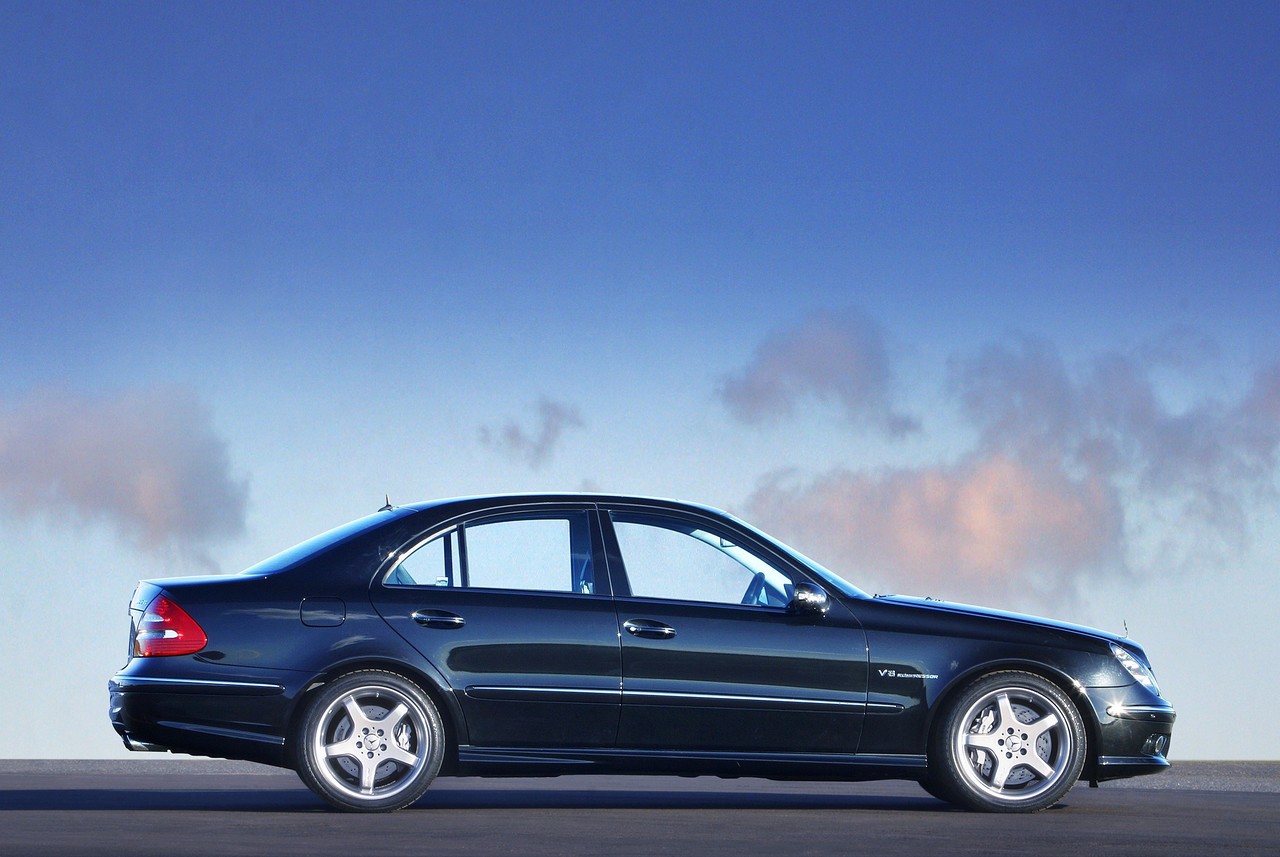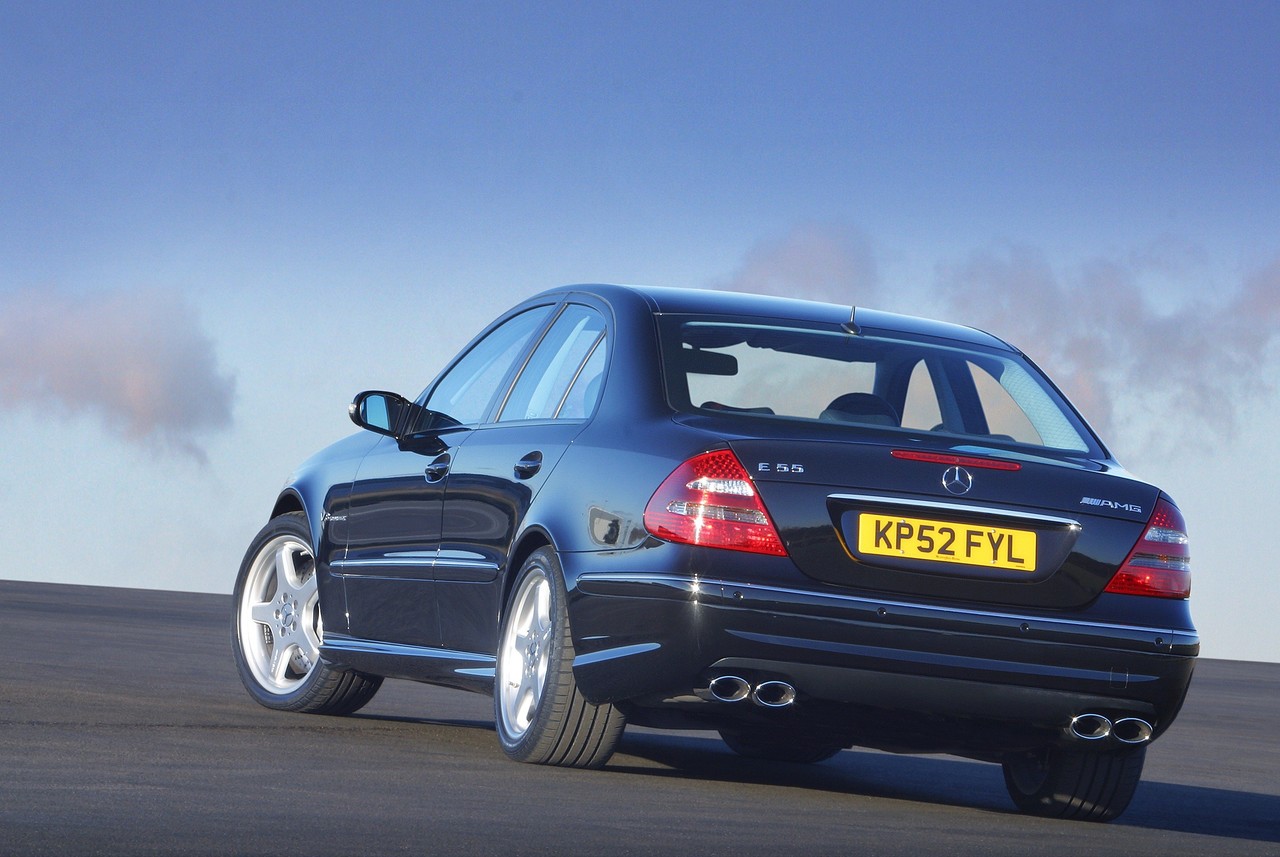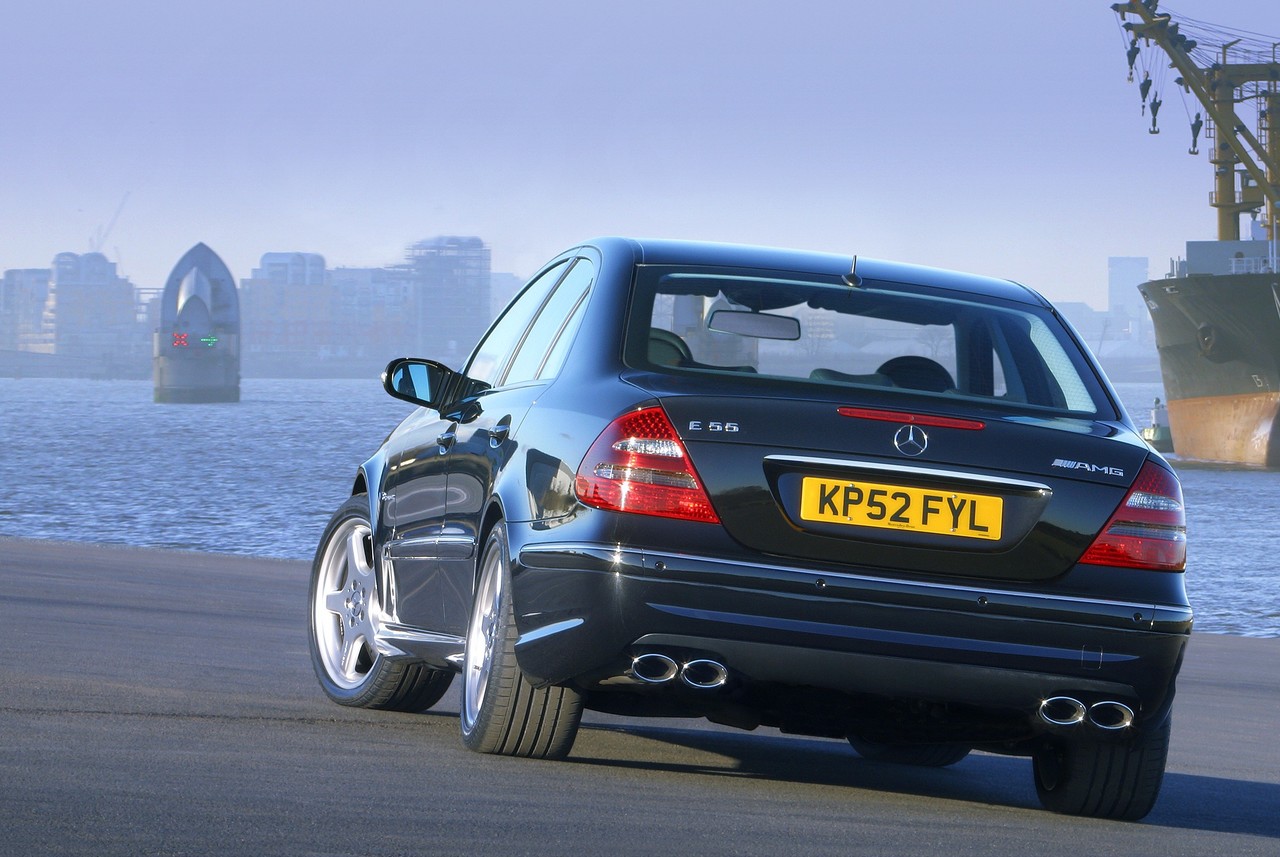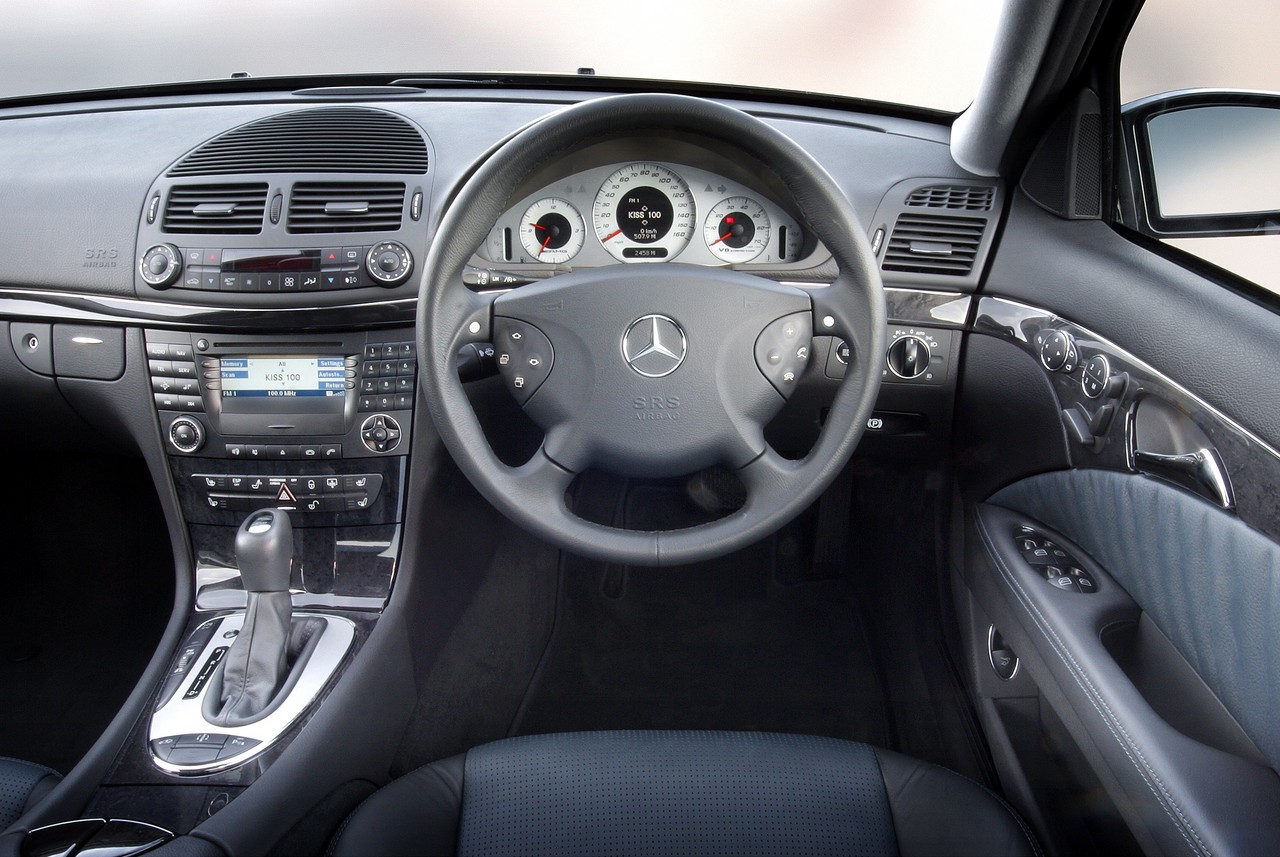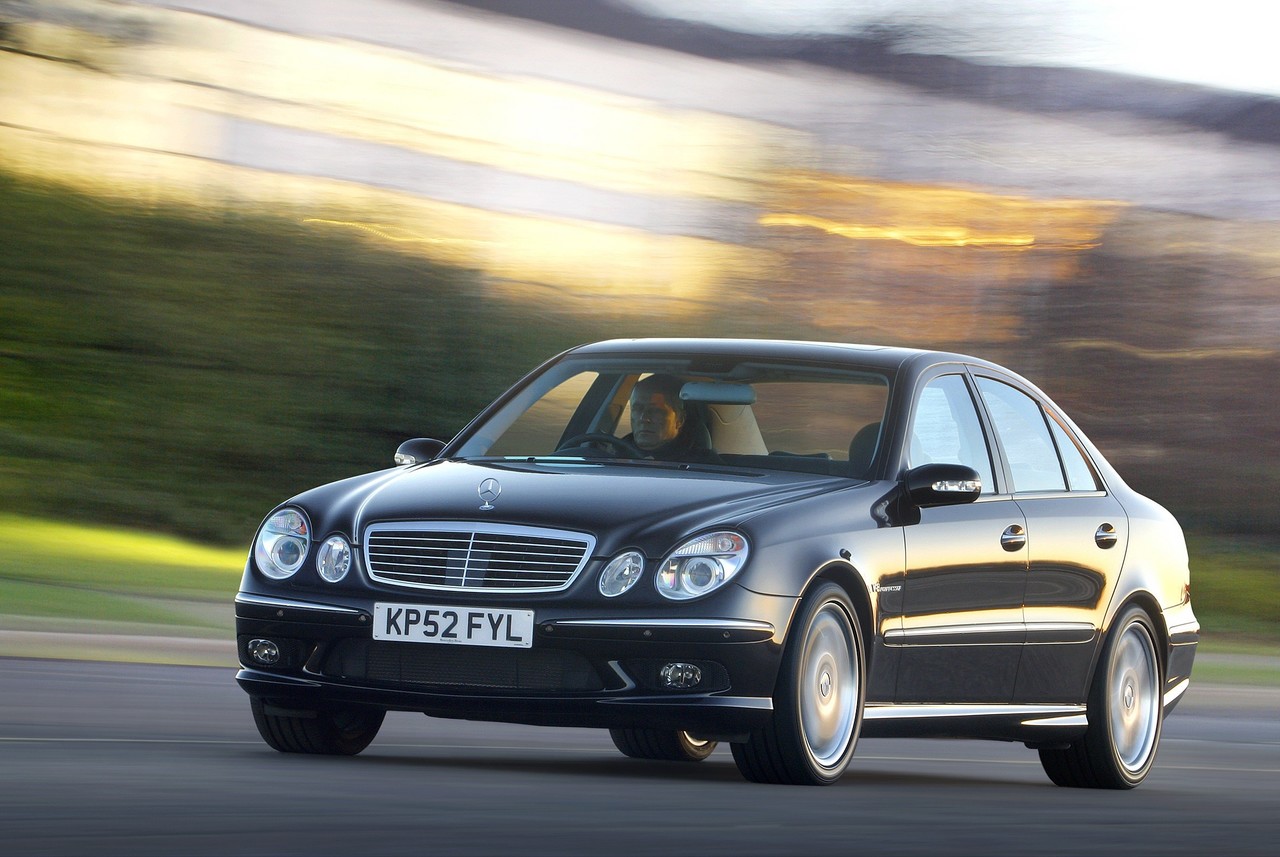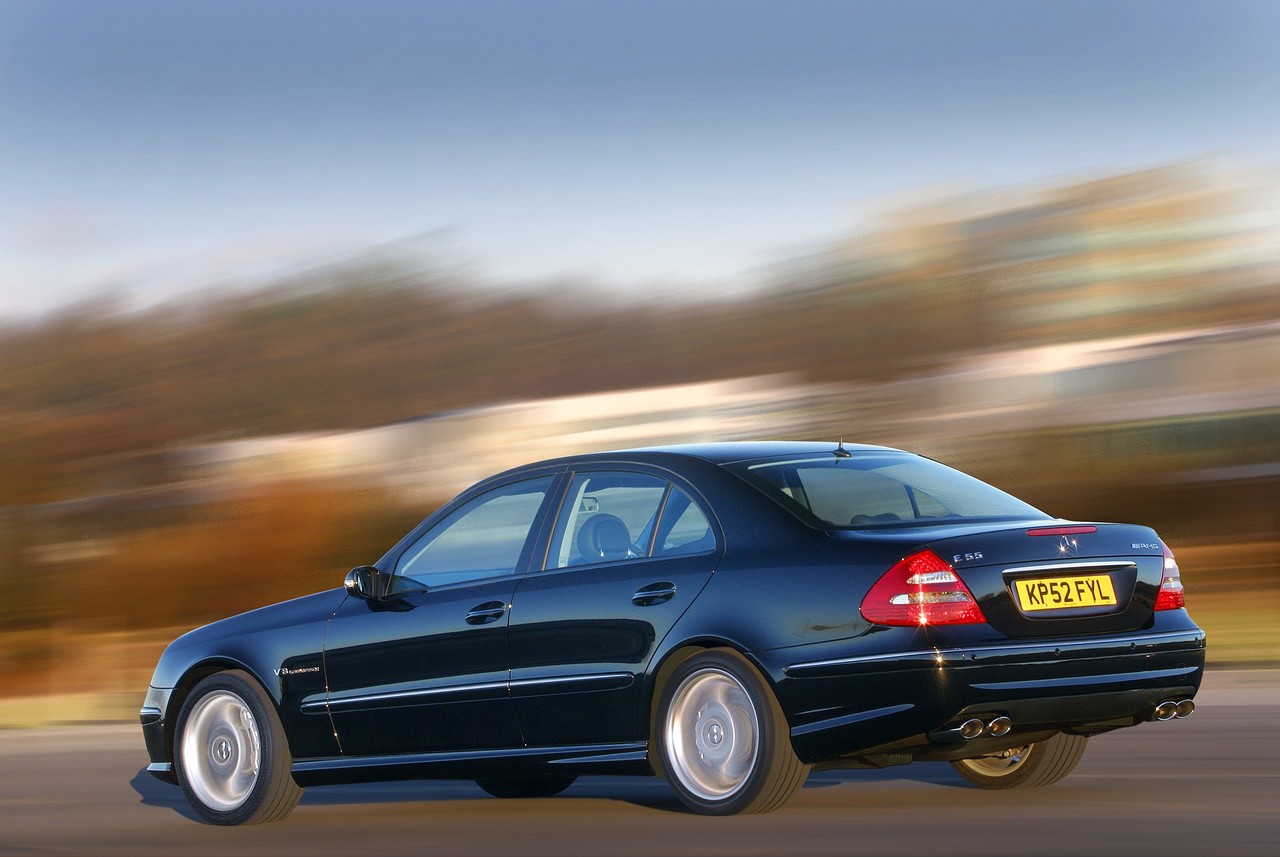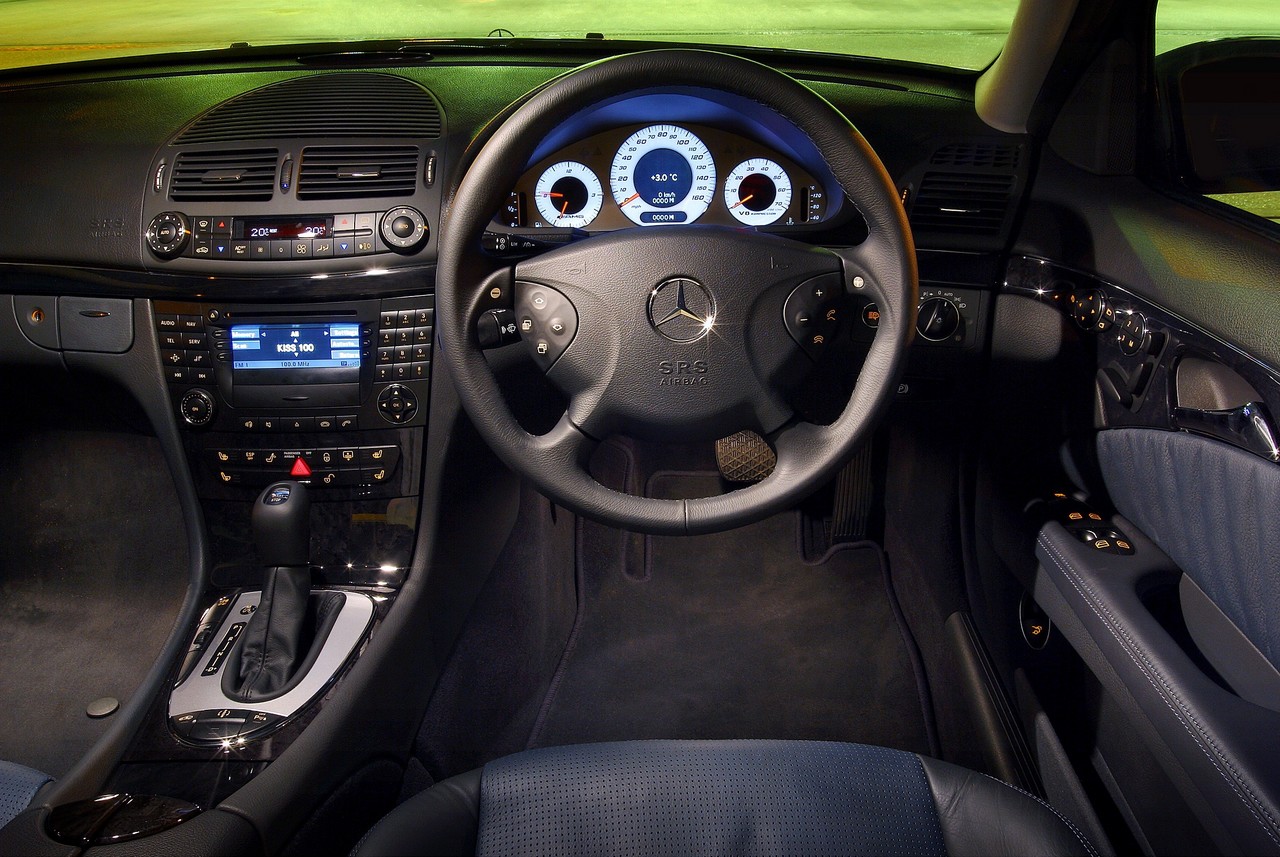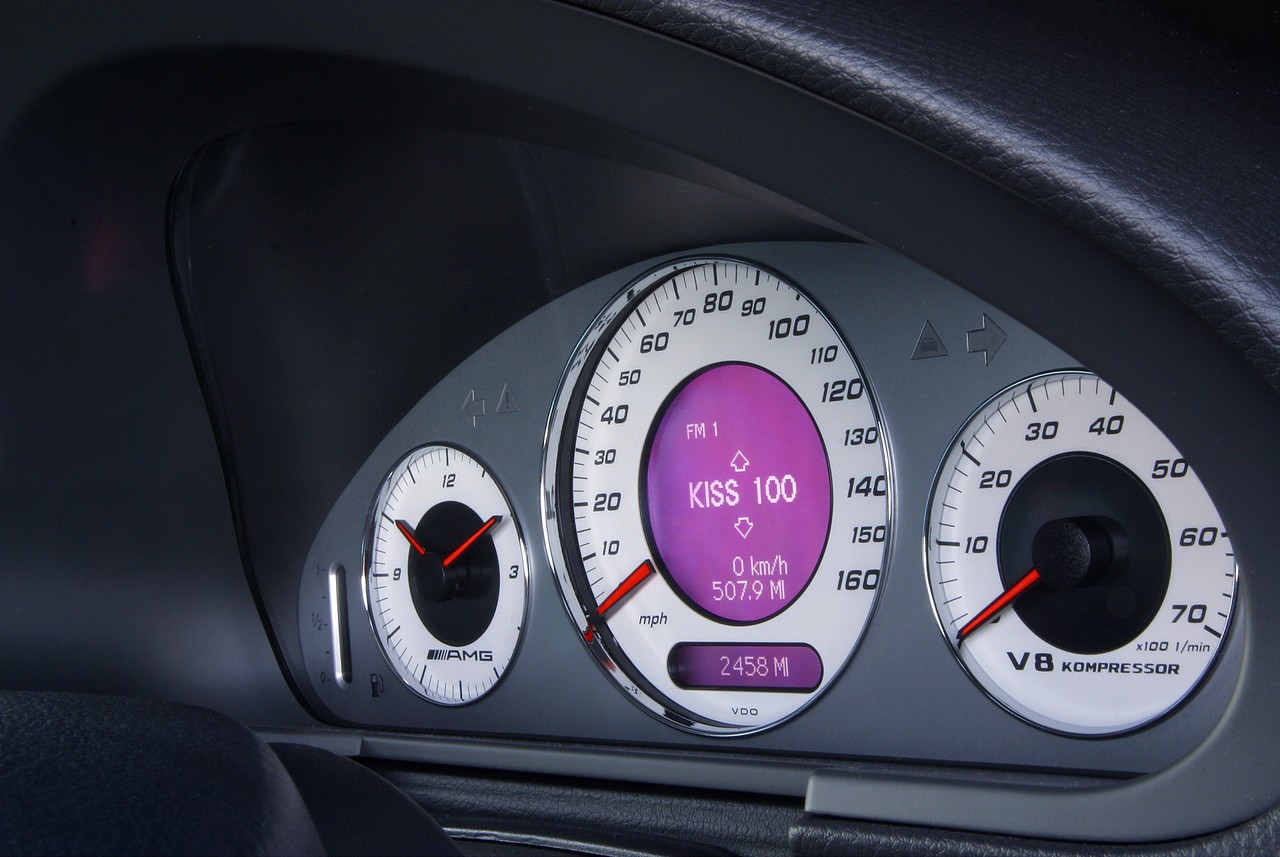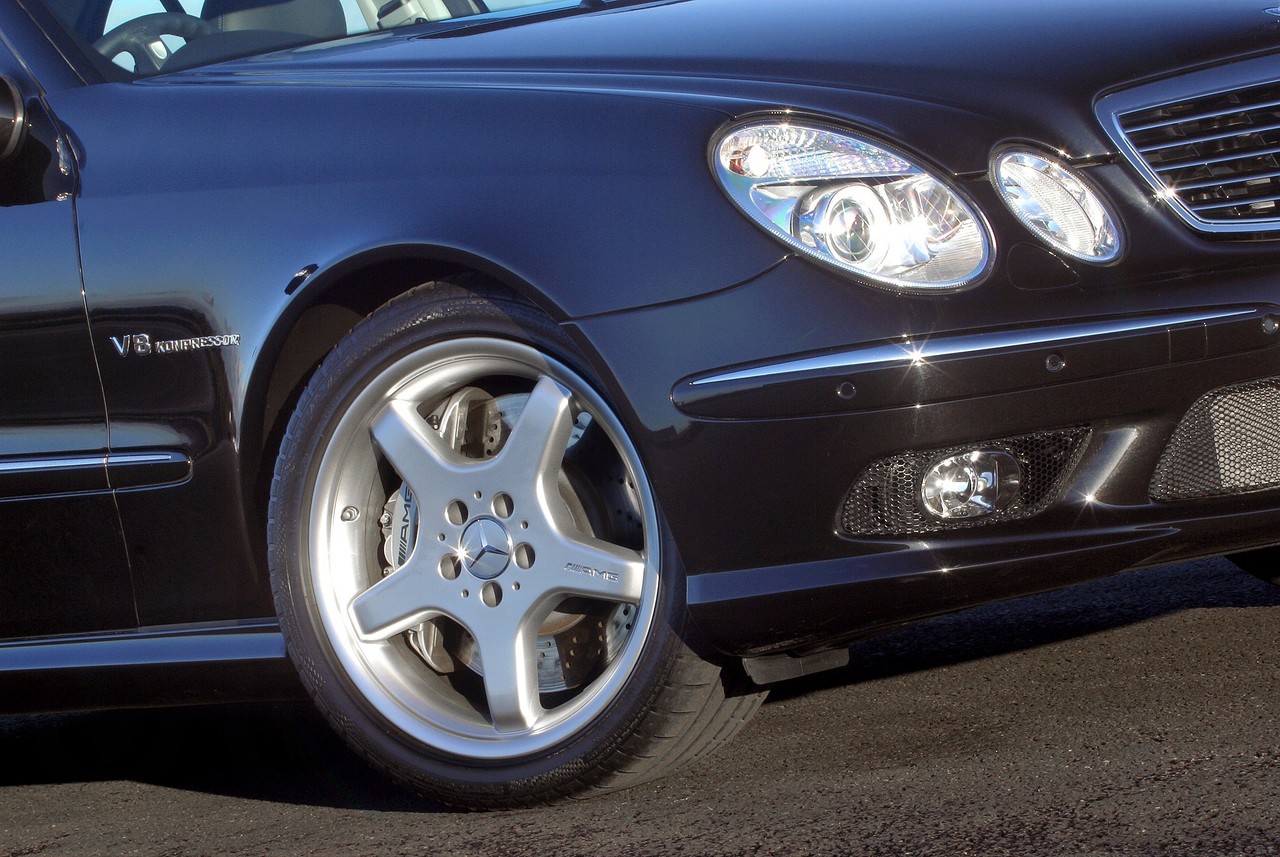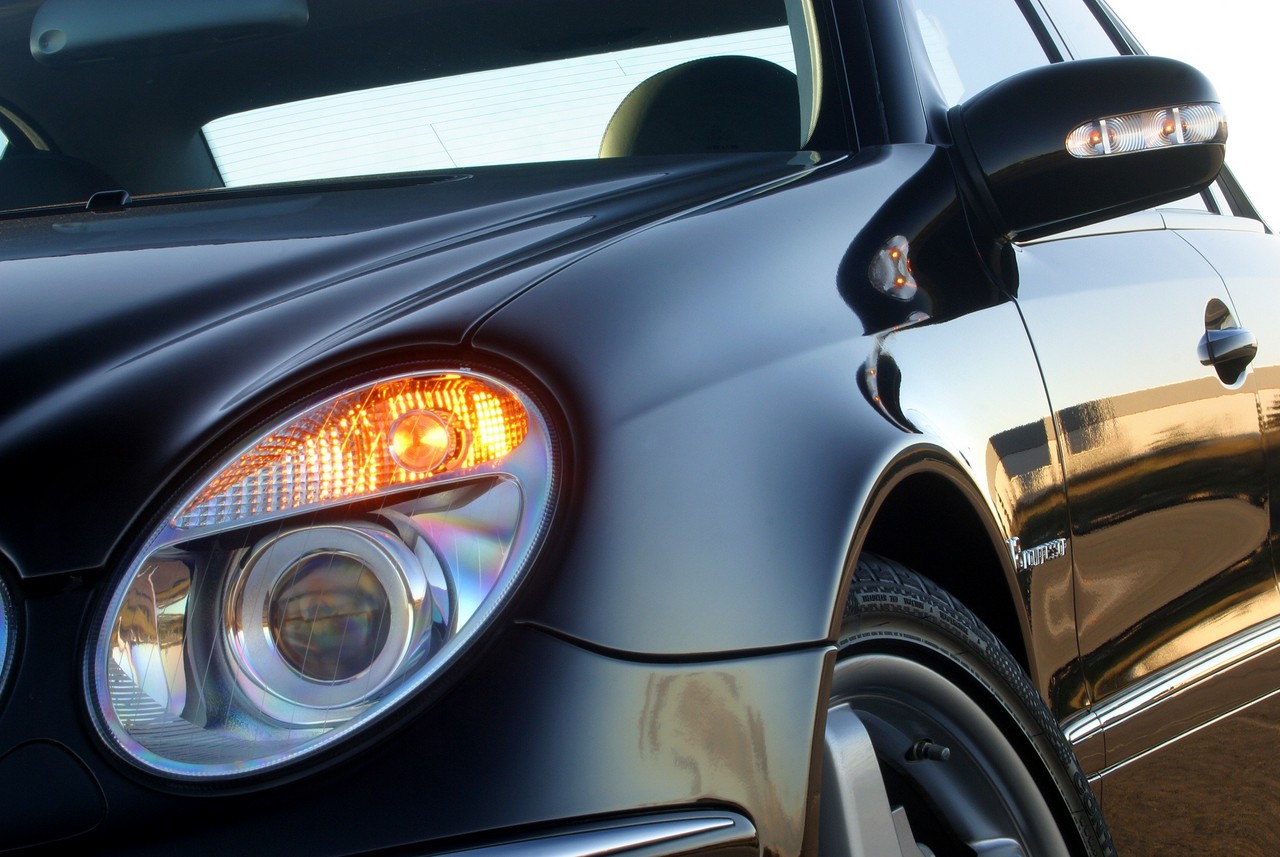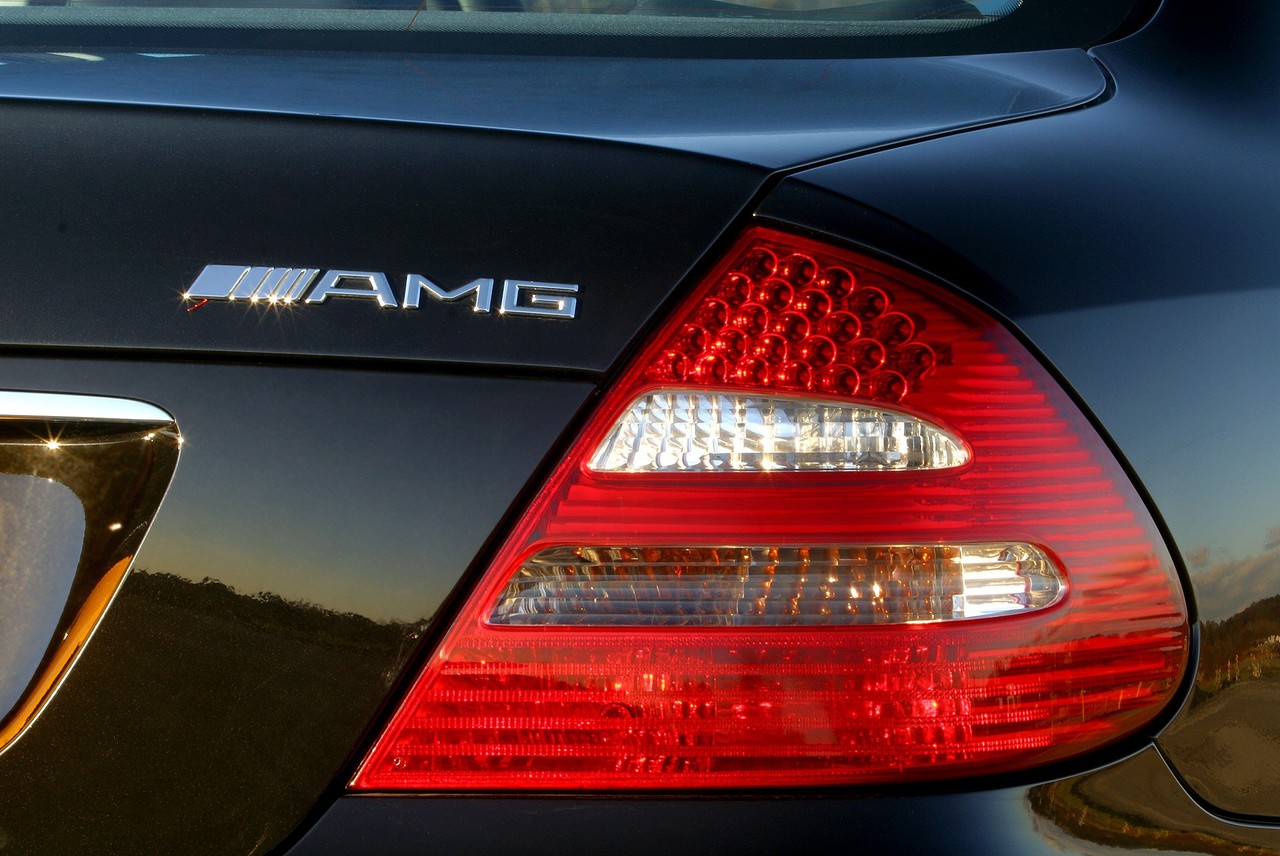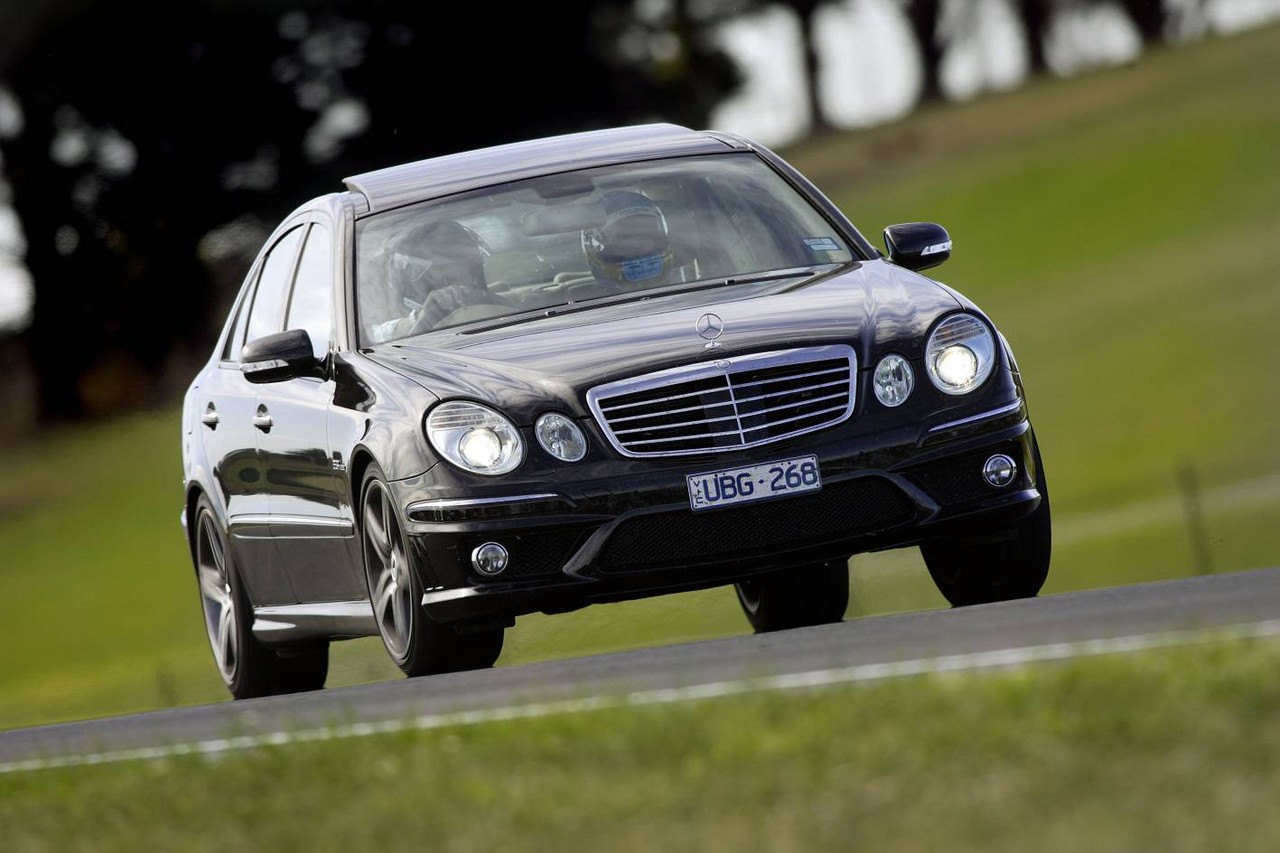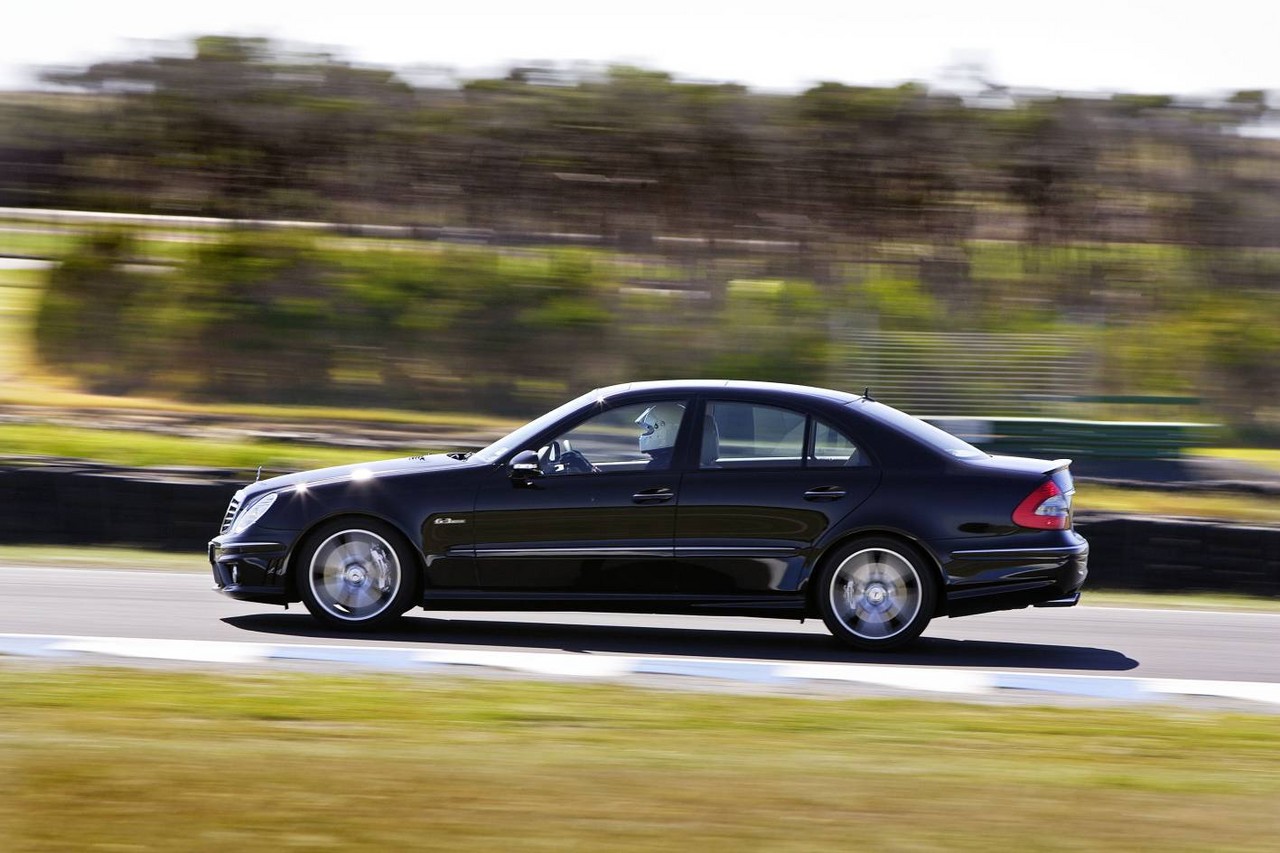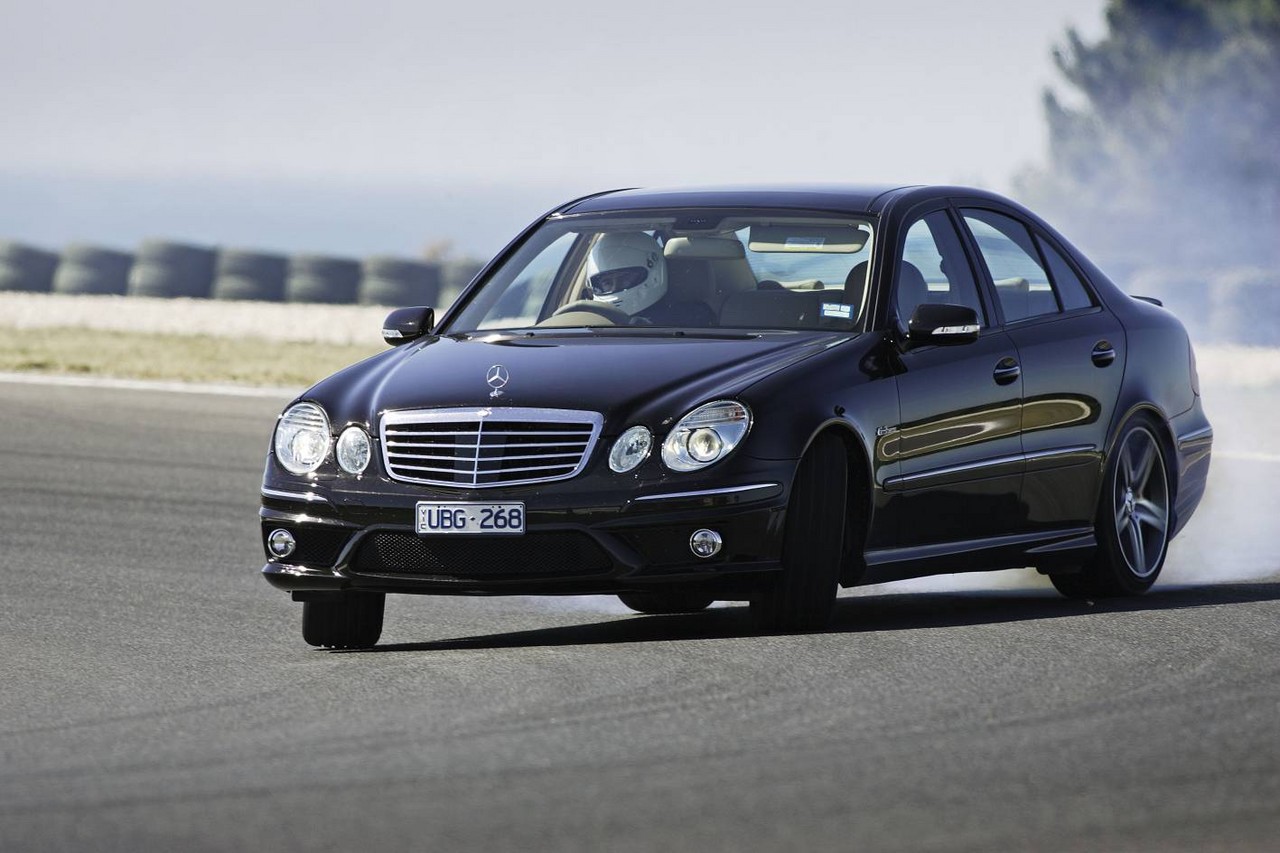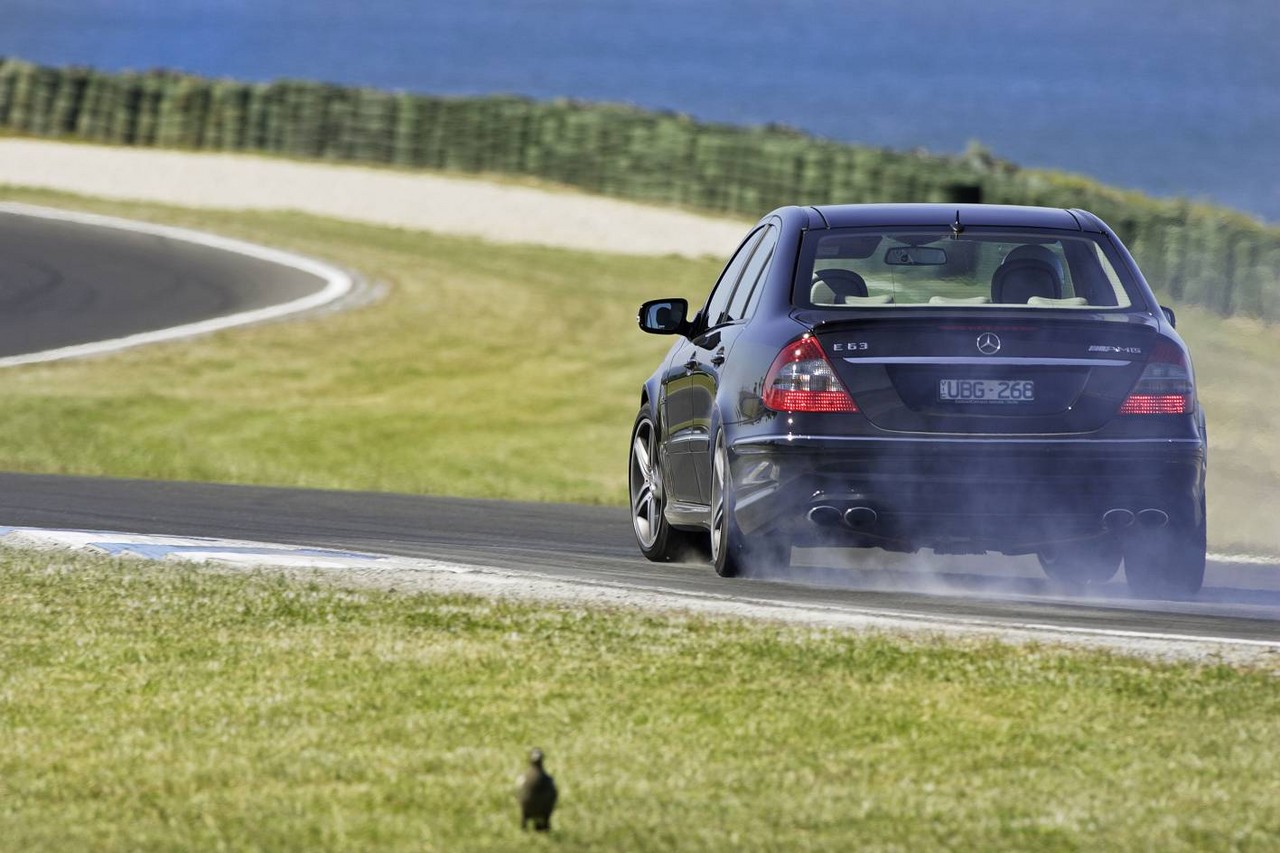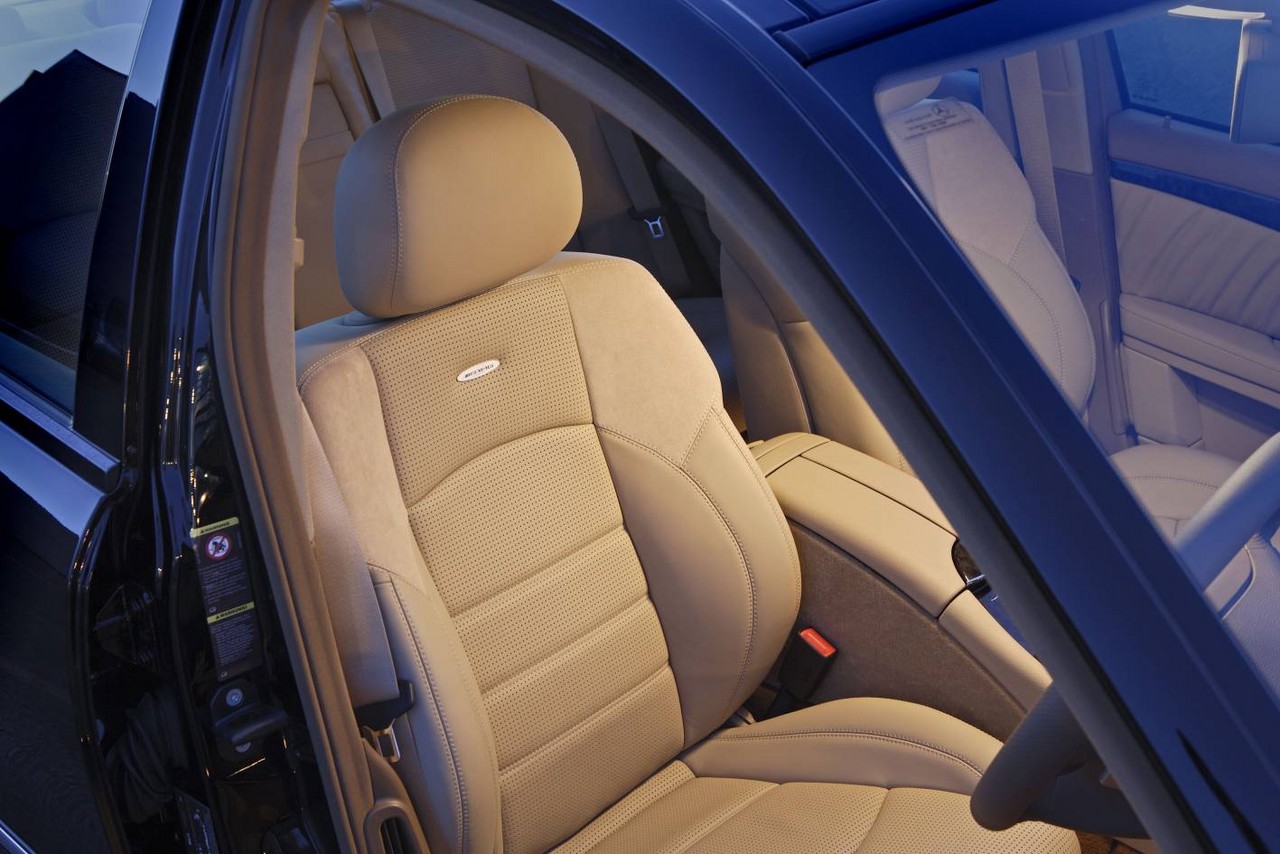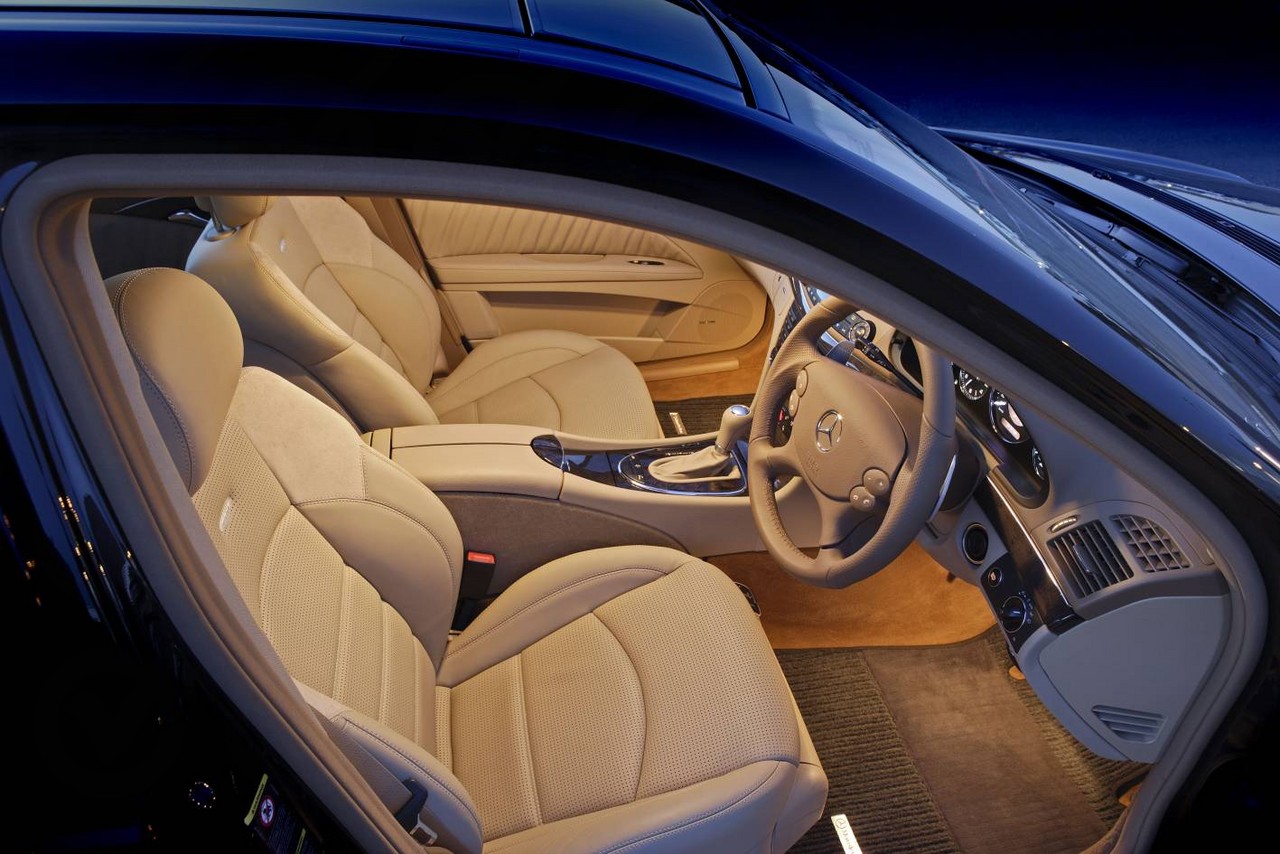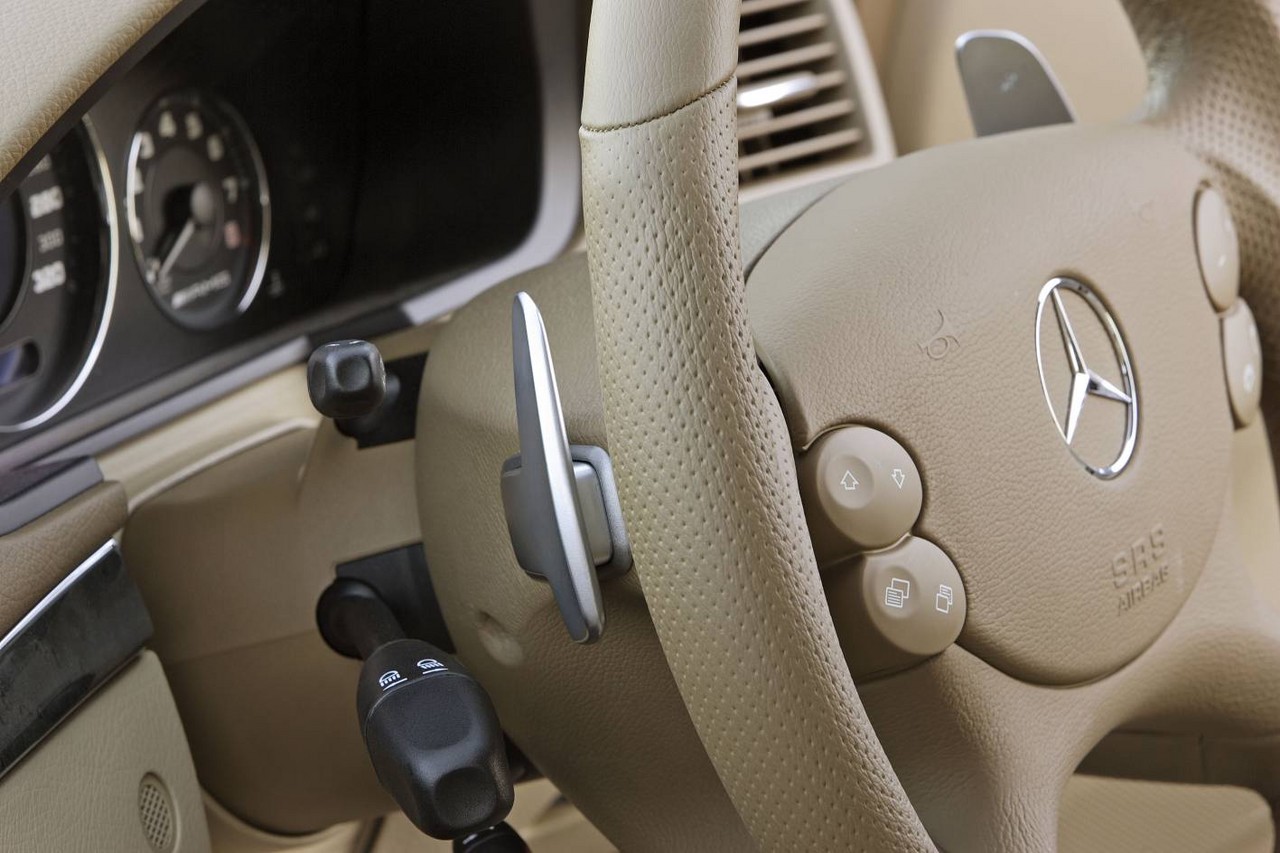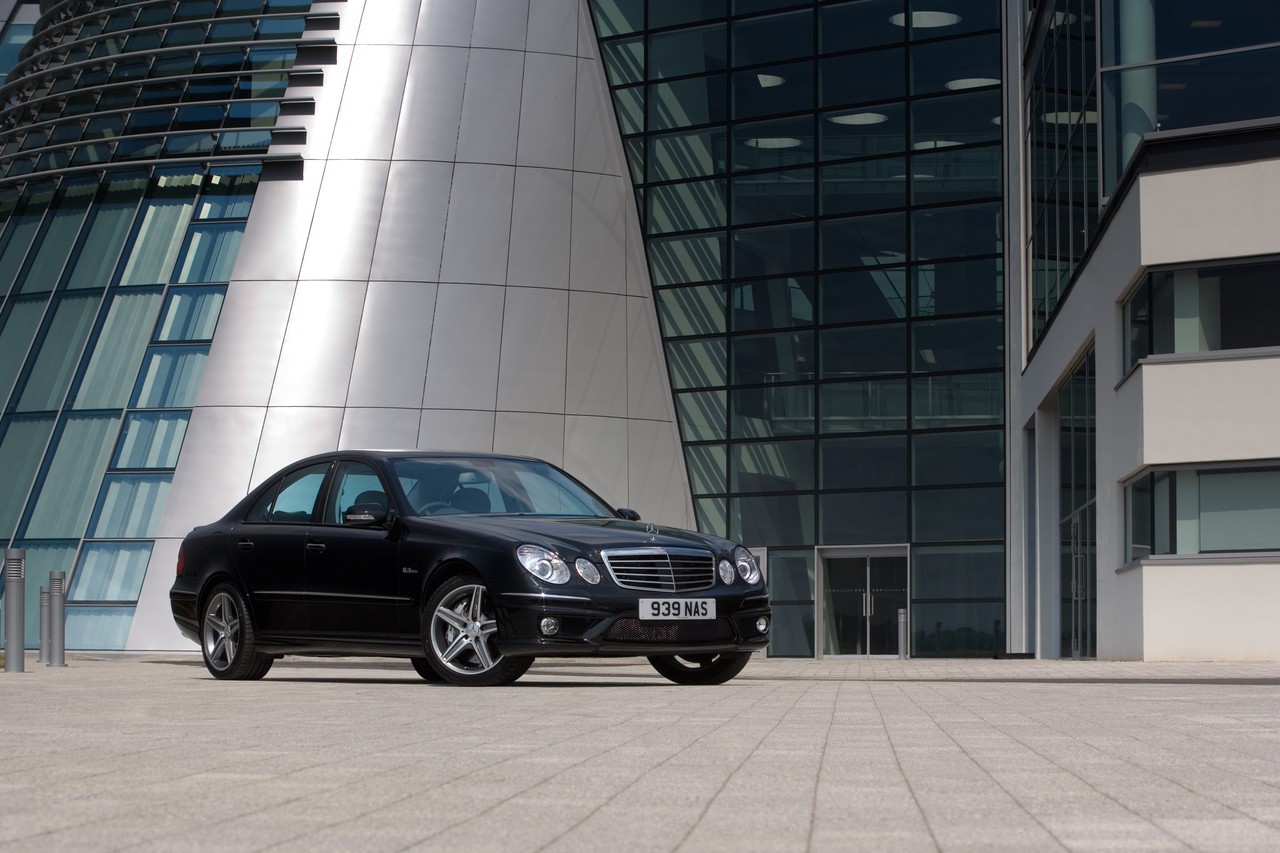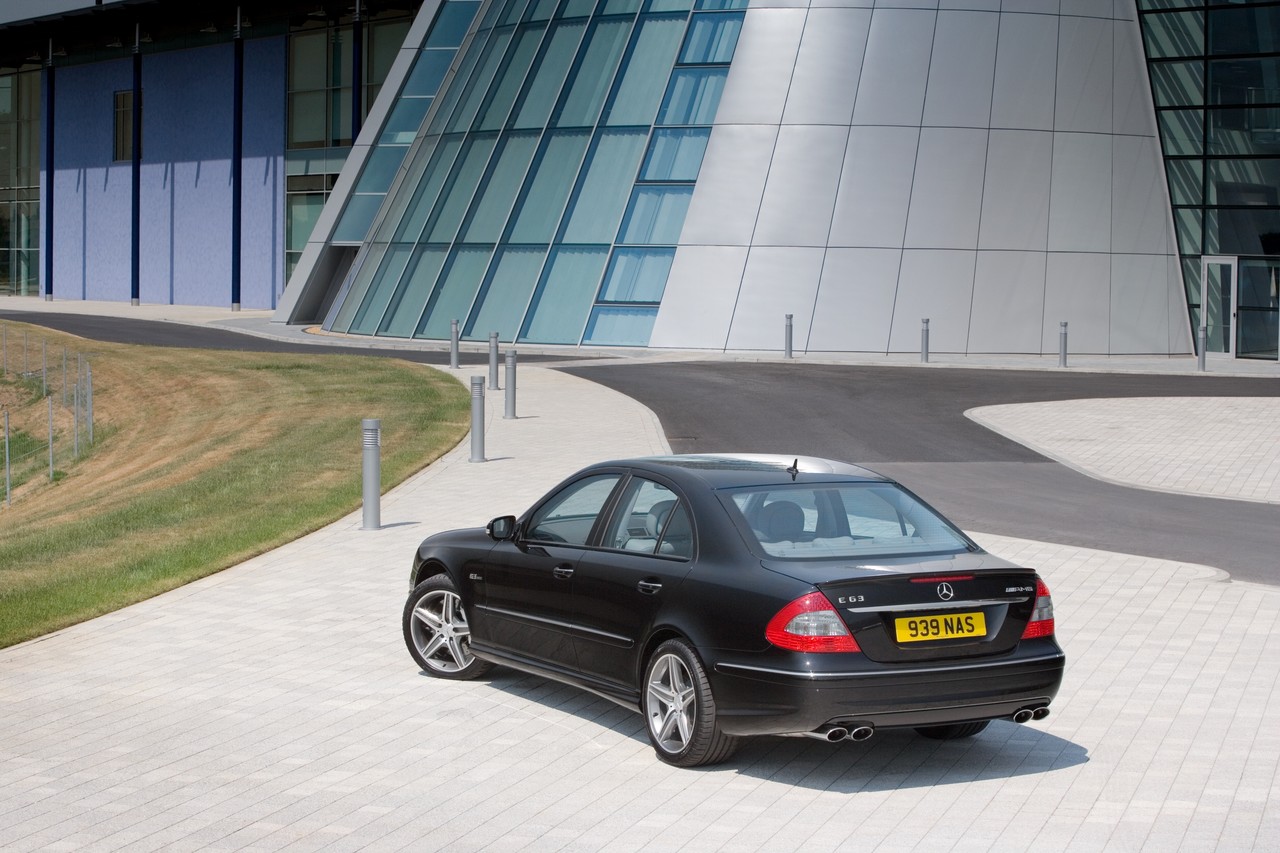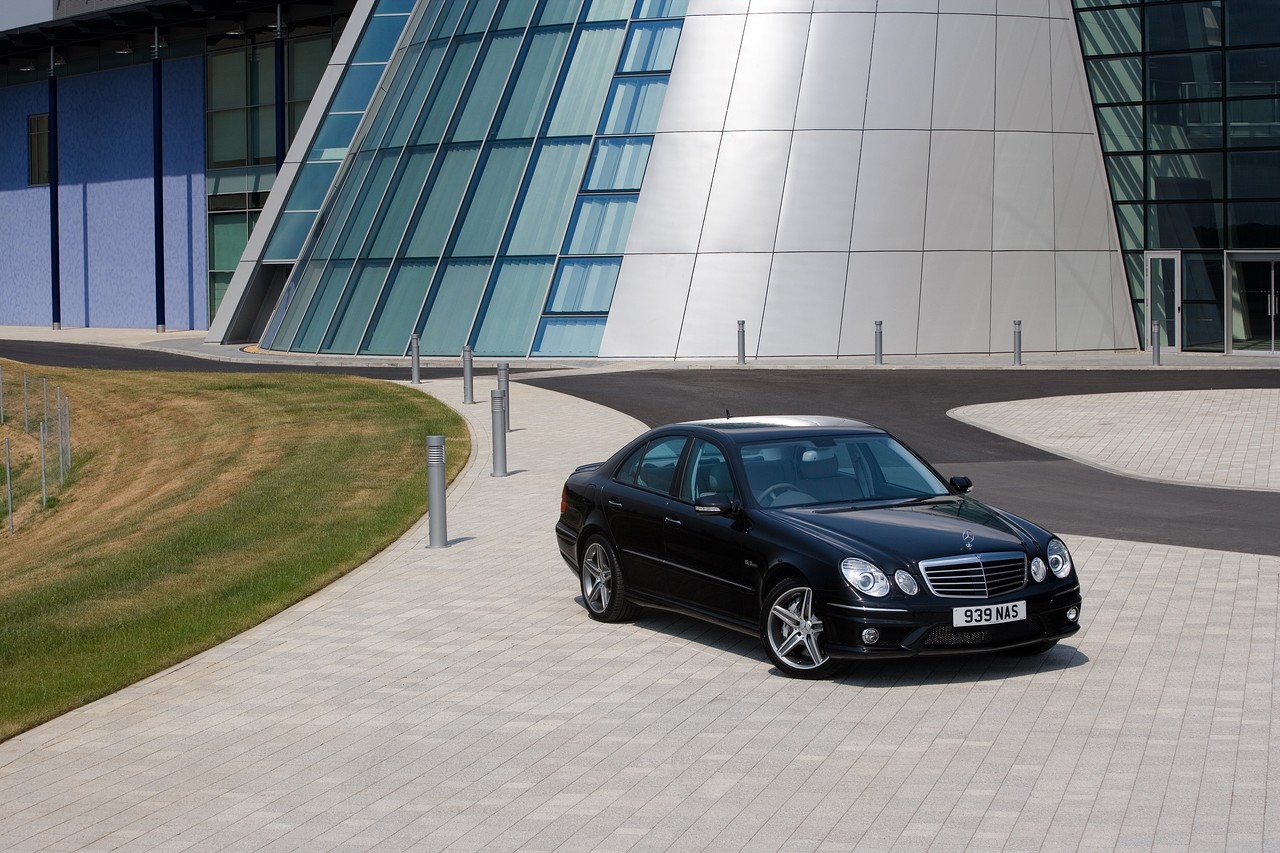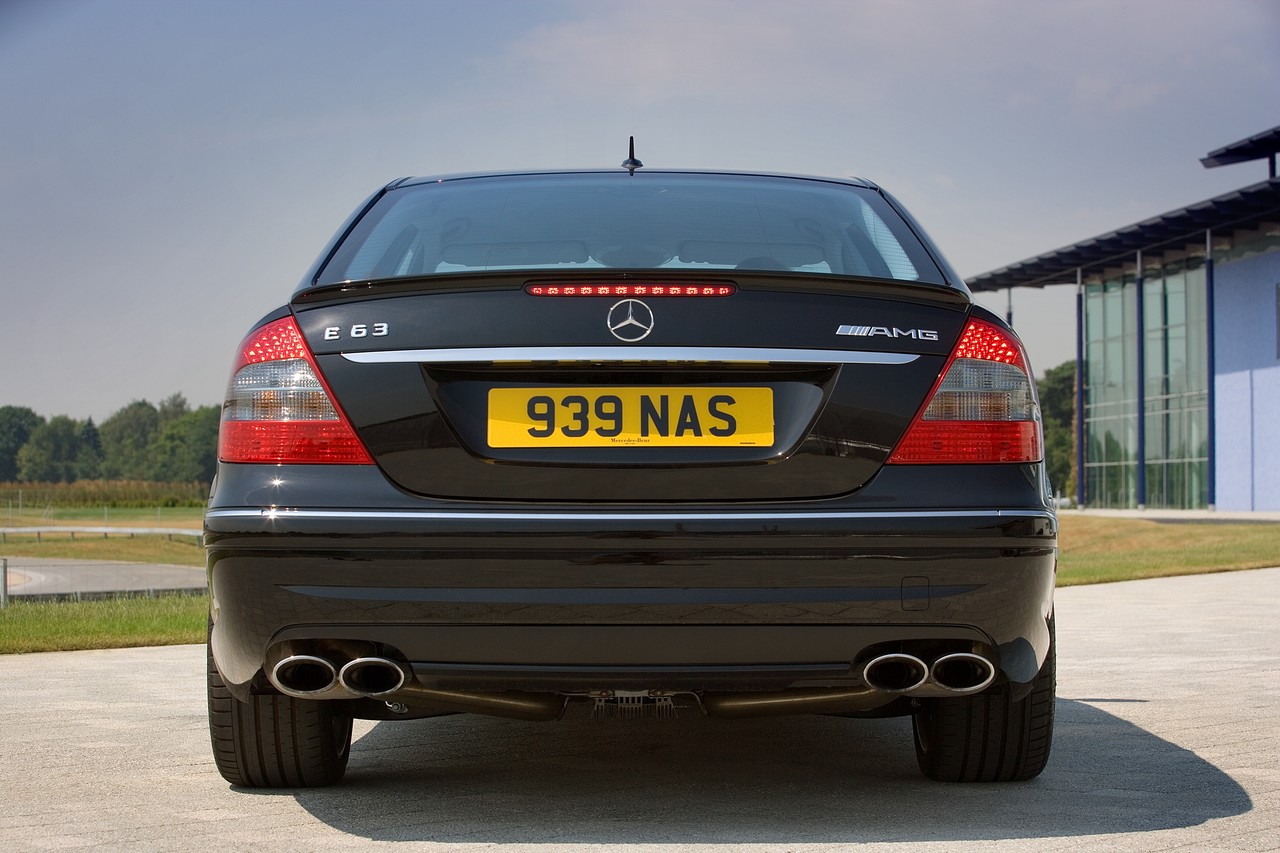
- M156 V8 engine susceptible to cylinder head bolt failure, camshaft lobe and valve lifter wear
- For E 55 AMG, sensitive brake pedal and steering lacks precision
- Suspension upset by mid-corner bumps
Review: Mercedes W211.I E 55 AMG sedan (2002-06)
Overview
Released in November 2002, the Mercedes-Benz W211 Series I (W211.I) E 55 AMG was an executive sedan. Manufactured in Sindelfingen, Germany, the rear-wheel drive W221.I E 55 AMG was powered by a 5.4-litre supercharged V8 petrol engine that was mated to a five-speed automatic transmission.
M113.990 V8 engine and supercharger
For the E 55 AMG, the 5439 cc M113.990 V8 engine had a die-cast alloy block with 97.0 mm bores and a 92.0 mm stroke, cast-in Silitec cylinder liners, fracture-split forged steel connecting rods, iron-coated aluminium pistons with oil spray cooling, an alloy cylinder head, a single overhead camshaft (SOHC) per cylinder bank driven by a double-roller chain, three valves per cylinder (two intake, one exhaust) actuated by roller rockers, two-spark plugs per cylinder, a dual-length intake manifold and a compression ratio of 9.0:1. While peak torque was 700 Nm from 2650-4000 rpm, the supercharged M113 engine produced 560 Nm at 1500 rpm and 650 Nm at 2000 rpm.
Unlike its naturally aspirated predecessor, the M113 engine for the W211 E 55 AMG engine had a Lysholm-type IHI supercharger – positioned between the cylinder banks – which provided maximum pressure of 0.8 bar and had an integrated air-water charge air cooler. The supercharger had two Teflon-coated aluminium shafts which rotated at up to 23,000 rpm, pushing 1850 kg of air per hour into the combustion chambers. To minimise fuel consumption at part throttle applications, the scroll compressor only operated at certain engine speeds and load conditions, activated by an electromagnetic coupling and a separate poly-V-belt.
Compared to its naturally aspirated counterpart in the W211 E 500 , changes for the supercharged M113 engine included:
- A reinforced crankcase with stiffening ribs and side bolts;
- A precision-balanced crankshaft with modified bearings and a more resistant material;
- Unique pistons;
- Forged connecting rods;
- A revised oil supply system (including the sump, catch tray and pump) and a separate oil cooler in the right-hand wheel arch;
- Optimised cylinder heads;
- A twin-spring assembly for the valve train to increased maximum engine speed to 6100 rpm (from 5600 rpm);
- A redesigned fuel system;
- A twin-pipe exhaust system with switchover valve and 70 mm diameter tailpipes for reduced exhaust gas back-pressure; and,
- A unique engine management system.
| Engine | Trans. | Peak power | Peak torque | |
|---|---|---|---|---|
| E 55 AMG | 5.4-litre s/charged petrol V8 (M113) | 5sp auto | 350 kW at 6100 rpm | 700 Nm at 2650-4000 rpm |
AMG Speedshift automatic transmission
The five-speed ‘AMG Speedshift’ transmission had three selectable modes:
- In standard (‘S’) mode, the transmission would monitor driving style and adapt gearshift behavior accordingly;
- In Comfort (‘C’) mode, the transmission would shift up earlier and downshift later, encouraging a more relaxed, fuel-efficient driving style; and,
- In manual (‘M’) mode, the driver could change gears using buttons on the steering wheel. When the rated engine speed was reached, the transmission would automatically shift up; and when the vehicle came to rest, first gear would be engaged automatically.
The transmission ratios for the ‘AMG Speedshift’ transmission were 3.60 (1st), 2.19 (2nd), 1.41 (3rd), 1.00 (4th) and 0.83 (5th), while the final drive ratio was 2.65. Furthermore, the transmission had a torque capacity of 1079 Nm.
Performance and fuel consumption
The Mercedes-Benz E 55 AMG could accelerate from rest to 100 km/h in 4.7 seconds and to 200 km/h in 16.1 seconds; top speed was electronically limited to 250 km/h. Over the combined NEDC cycle, fuel consumption was 12.9 litres per 100 km.
Dimensions and body
Compared to the W210 E 55 AMG , the W211 E 55 AMG was the same length (at 4818 mm), 23 mm wider (1822 mm), 41 mm taller (1452 mm) and had a 21 mm longer wheelbase (2854 mm); kerb weight increased by 125 kg to 1835 kg. Furthermore, torsional rigidity increased by 18 per cent, in part due to the greater use of high-strength steel alloys.
Suspension
The Mercedes-Benz W211 E 55 AMG had newly developed four-link front suspension and multi-link independent rear suspension. Furthermore, the E 55 AMG had Mercedes-Benz’s ‘Airmatic DC’ semi-active air suspension with ‘Adaptive Damping System II’ which used sensors to monitor steering and yaw angle, longitudinal and transverse acceleration, vehicle level and driving style to adapt the damping and springs to the situation. The driver could also select make a manual selection from three different settings. When 140 km/h was exceeded, the suspension would lower the body by 15 mm to reduce aerodynamic drag, and return to its normal level when the speed was less than 70 km/h.
Compared to the W211 E-Class , changes for the W211 E 55 AMG included new AMG spring struts with lower air volume for faster responses, AMG shock absorbers and stronger stabiliser with 50 per cent greater torsional rigidity.
Steering
The Mercedes-Benz E 55 AMG had rack-and-pinion steering which included speed-sensitive power assistance (Mercedes-Benz’s ‘parameter’ steering).
Safety equipment
Standard safety equipment for the Mercedes-Benz E 55 AMG included dual front airbags (with two-stage deployment), front and rear side airbags, full-length curtain airbags, ABS, brake assist, electronic brake force distribution, electronic stability control, traction control and front and outer rear seatbelts with pre-tensioners and load limiters.
Shared with the W211 E-Class, the E 55 AMG was fitted with Mercedes-Benz’s ‘Sensotronic Brake Control’ system which included:
- a ‘dry braking function’ for wet weather driving by applying regular, short brake impulses to remove water from the brake discs;
- increased braking pressure on the outer wheels of the vehicle when cornering; and,
- a ‘Softstop’ function which reduced braking power as the vehicle came to rest for smooth stops in city traffic.
Brakes: E 55 AMG
The Mercedes-Benz W211 E 55 AMG had 360 mm by 36 mm vented front brake discs with eight-piston callipers and 330 mm by 26 mm vented rear discs with four-piston rear callipers.
Euro NCAP crash testing
In Euro NCAP crash testing , a 2002 Mercedes-Benz W211 E 220 CDI received a five star adult occupant protection rating with a score of 32.95 out of 37; this result, however, included two points for seatbelt reminders which were not introduced to Australian-delivered models until mid-2004. In the frontal offset crash test, there was a slight risk of serious injury for the front occupants; in the side impact test, there was a slight risk of serious chest injury.
Features: Mercedes-Benz E 55 AMG
Standard features for the Mercedes-Benz E 55 AMG included 8.0J x 18-inch front alloy wheels with 245/40 ZR18 front and 9.0J x 18-inch rear alloy wheels with 265/35 ZR18 rear tyres, a ten speaker ‘Audio 20’ sound system with a six-disc CD player, Mercedes-Benz’s COMAND APS (Mercedes-Benz’s Cockpit and Data Management System) with satellite navigation, 6.5-inch colour display and DVD player, four-zone climate control air conditioning (‘Thermotronic’), Nappa/Nubuck leather upholstery, contoured AMG front sports seats with power adjustment and heating, cruise control with variable speed limiter (‘Speedtronic’), bi-xenon headlights with washers, front and rear fog lamps, automatic headlights, rain-sensing wipers, an AMG sports steering wheel with gearshift buttons, remote central locking, power windows and heated mirrors, a power adjustable steering column (for height and reach), memory settings (front seats, steering wheel and mirrors), a power-operated glass sunroof, tinted windows, black bird’s eye maple wood trim, a trip computer and immobiliser.
Review: Mercedes W211.II E 63 AMG sedan (2006-09)
Overview
Released in September 2006, the introduction of the Mercedes-Benz W211 Series II (W211.II) range saw the E 63 AMG replace the E 55 AMG. The W211 E 63 AMG was powered by a naturally aspirated 6.2-litre V8 petrol engine that was mated to a seven-speed automatic transmission.
Visually, the W211.II E 63 AMG could be identified by its deeper V-shaped grille, new bumpers, front fog lights, five-spoke alloy wheels, tail-lights and door mirrors. The E 63 AMG was also fitted with a rear ‘breakaway edge’ bootlip which, according to Mercedes-Benz, reduced lift at the rear axle by up to 30 per cent. Inside, there was a new four-spoke steering wheel (shared with the CLS-Class), climate control unit, upholstery and auto-dimming rear view mirror.
M156.982 V8 engine
Developed and hand-assembled by Mercedes-AMG in Affalterbach, Germany, the 6208 cc M156 V8 petrol engine had an aluminium-silicon alloy (AlSi7) block which had 102.2 mm bores and a 94.6 mm stroke, an aluminium-silicon alloy (AlSi17) cylinder head, a Cromax 42CrMo4V forged steel alloy crankshaft, fracture-split forged connecting rods, cylinder bores with twin-wire-arc-sprayed (TWAS) coating, Bosch 9.7 engine management system, double overhead camshafts per cylinder bank (intake cams driven by a double chain from the crankshaft and small gears on the intake cams drive the exhaust camshafts), continuously variable intake and exhaust camshafts (over a range of 40 degrees via electrohydraulic vane-type adjusters), four valves per cylinder (40 mm intake valves and 34 mm exhaust valves), bucket tappets, a magnesium variable intake manifold (with two electrically-operated internal flaps) and a compression ratio of 11.3:1.
AMG Speed Shift transmission
The seven-speed ‘AMG Speed Shift’ automatic transmission and had three individual shift programs, including a manual mode in which the driver could perform gearshifts using the aluminium steering wheel gearshift paddles.
The transmission ratios for the ‘AMG Speedshift’ transmission were 4.38 (1st), 2.86 (2nd), 1.92 (3rd), 1.37 (4th), 1.00 (5th), 0.82 (6th) and 0.73 (7th), while the final drive ratio was 2.82. Furthermore, the transmission had a torque capacity of 735 Nm.
Performance and fuel consumption
The W211 E 63 AMG could accelerate from rest to 100 km/h in 4.5 seconds and had an electronically-limited top speed of 250 km/h. Over the combined ADR 81/02 test cycle, fuel consumption for the E 63 AMG was 14.3 litres per 100 km.
| Engine | Trans. | Peak power | Peak torque | |
|---|---|---|---|---|
| E 63 AMG | 6.2-litre petrol V8 (M156) | 7sp auto | 378 kW at 6800 rpm | 630 Nm at 5200 rpm |
Safety equipment
Compared to its E 55 AMG predecessor, standard safety equipment for the Mercedes-Benz E 63 AMG was revised as:
- The Sensotronic braking system was discontinued and replaced by Mercedes-Benz’s ‘Adaptive Brake’ which included a hill holder function;
- Active front seat head restraints (‘Neck-Pro’) were introduced; and,
- Mercedes-Benz’s ‘Pre-Safe’ system – which could anticipate and prepare for collisions by by tensioning the seatbelts, adjusting the seats and closing the sunroof – was fitted as standard.
For the E 63 AMG, the electronic stability control system could be deactivated.
Brakes: E 63 AMG
The Mercedes-Benz E 63 AMG had 360 mm by 36 mm composite front brake discs with six-piston callipers and 330 mm by 26 mm rear discs with four-piston brake callipers; both front and rear discs were internally ventilated and perforated.
Features: Mercedes-Benz E 63 AMG
Compared to the E 55 AMG, standard features for the Mercedes-Benz E 63 AMG were revised to include AMG sports seats with nappa leather upholstery and alcantara inserts, and ‘Racetimer’ function which enabled the driver to measure lap times on an enclosed race track.
Related links
- Press Kit: Mercedes-Benz W211.II E-Class (April 2006)
- Specifications: Mercedes-Benz W211.II E-Class Sedan and S211.II E-Class Estate (September 2006)
- Wikipedia.org: Mercedes-Benz W211 E-Class
